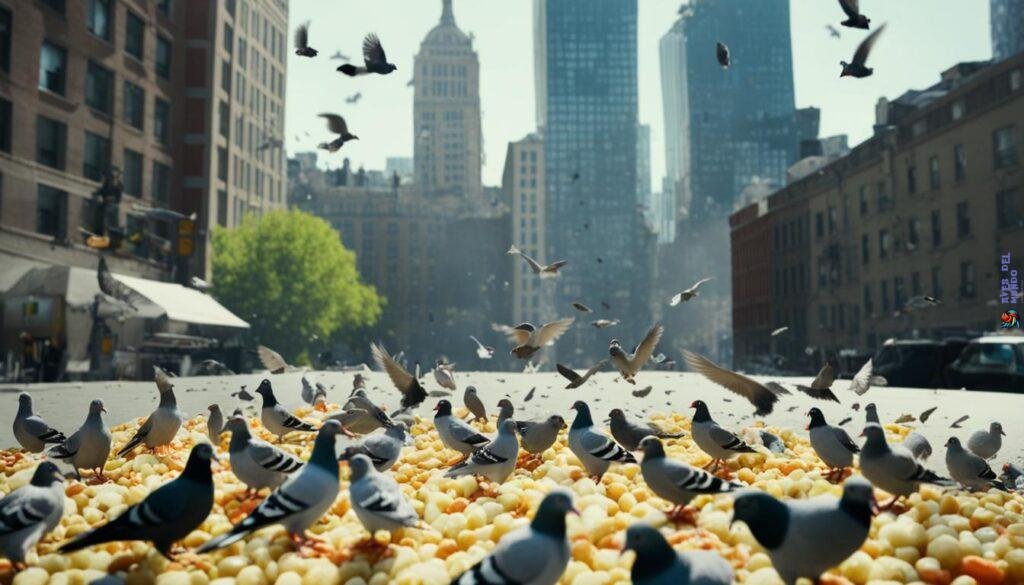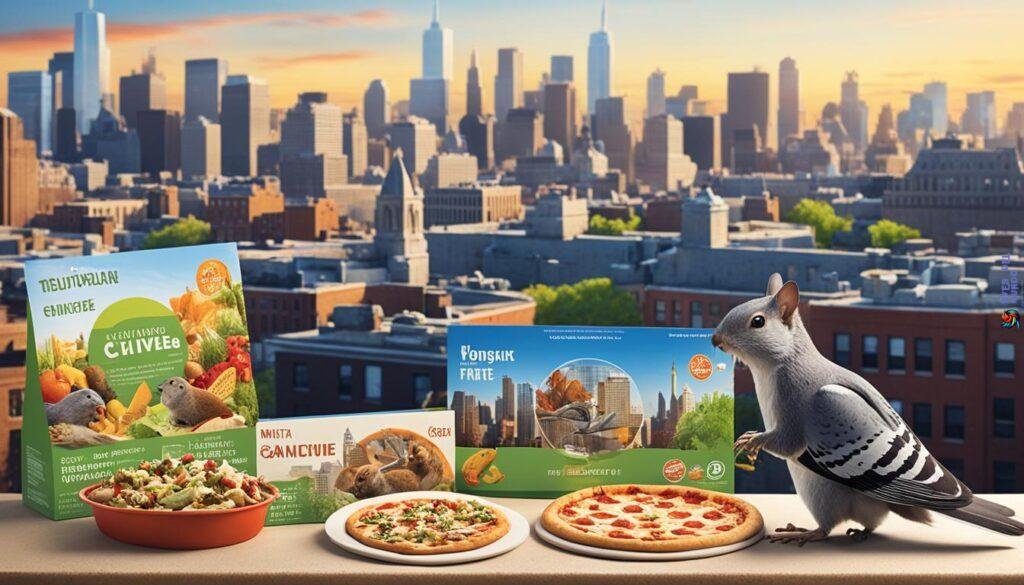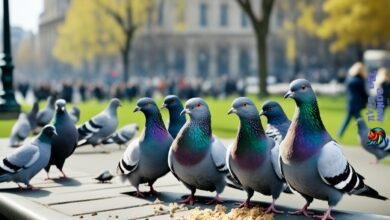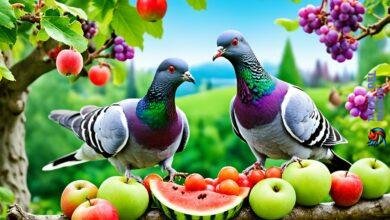Over 400 million pigeons call our urban areas home. They fly around, living where people and urban wildlife diet overlap. Many believe they know what pigeons eat, but they’re often wrong. Pigeons don’t hunt rats. Instead, they prefer fruits, seeds, and some insects. Their diet doesn’t match the scary stories told about them.
When we feed pigeons, it’s like we’re connecting with nature. But, are we giving them what they really need? Myths mislead us. They say pigeons eat rats or rice will make them explode. Both are false. Pigeons are actually very adaptable and can eat many things, including rice. Understanding this helps us feed pigeons better and connect with nature in our cities.
The Lifespan of Urban Pigeons and Dietary Adaptations
Understanding how urban pigeons eat helps us see why they live long in cities. These birds adapt their diet to live in our concrete jungles. Their ability to thrive amidst urbanization shows how flexible urban animal diets and behaviors are.
Resilience and Adaptability: Key to Pigeon Survival in Cities
Pigeons are both tough and adaptable. This mix lets them thrive in city landscapes. Their varied diet is key to their long lives. The versatility of a pigeon’s diet helps them outlive many other city birds.
Scavenger Lifestyle: Exploring Pigeon Foraging Behavior
Pigeons are natural scavengers in cities. This lifestyle is closely linked to their survival tactics. They forage for food scraps and navigate trash for nourishment. This shows their ability to survive in urban settings.
Despite myths, pigeons safely eat various foods, including rice, without getting sick. They are great at using different urban foods to stay alive.
| Food Source | Role in Diet | Benefits |
|---|---|---|
| Seeds and Grains | Foundation | Provides complex carbohydrates and essential nutrients |
| Insects | Protein | Supplies protein for growth and repair |
| Food Scraps | Opportunistic Feeding | Offers immediate energy and diverse nutrients |
| Rice | Alternative Source | Safe carbohydrate, despite misconceptions about harm |
Pigeons aren’t picky with food, but their ability to eat different foods helps them survive. Urban areas offer many food choices from trash and litter. This shows how wildlife interacts with city life.
Feeding pigeons properly can improve their behaviors and interactions in cities. Even though they eat differently in cities, urban pigeons show great adaptability.
Do pigeons eat rats? Separating Fact from Fiction
Understanding bird predation habits helps clarify our urban feathered friends’ diets. Many wonder, «do pigeons eat rats?» This curiosity stems from common myths about pigeons’ eating habits. In truth, pigeons don’t hunt rats. They mostly eat seeds, grains, and insects.
Pigeons adapt but stick to their natural diet even in cities. They may search for food in waste areas, where rats are. But, it’s wrong to think they control rat populations by eating them.
Contrary to urban legends, pigeons do not engage in hunting or preying on rats. Their role in the ecosystem does not contribute significantly to the suppression of the rat population.
This belief causes misunderstandings about pigeons. In cities, it’s key to know pigeons’ real feeding habits. Accurate knowledge helps us support a balanced, healthy urban ecosystem for everyone.
Debunking the Rice Myth: Can Pigeons Safely Eat Grains?
Some people worry about feeding pigeons rice, but these concerns are often based on myths. In this section, we’ll uncover the truth about rice and pigeons. You’ll learn that pigeons can safely eat rice and how it’s a good part of their diet.
Rice in Pigeon Diet: A Harmless Food Source Explained
Many think rice is bad for pigeons, but that’s not true. Pigeons eating rice at parks or city places is okay. Their strong stomachs break down rice easily, providing them with needed energy.
Understanding the Pigeon’s Digestive System
Pigeons have a special organ called the gizzard for digestion. The gizzard helps them grind up rice and other hard foods. So, pigeons can eat both cooked and raw rice without any problems.
How Much Rice is Too Much for a Pigeon?
Rice is fine for pigeons in moderation, like all foods. But, feeding them too much rice can cause dietary issues. To keep pigeons healthy, mix rice with fruits, veggies, and bird seeds.
Remember these points to help keep urban ecosystems and pigeons healthy. Responsible feeding is key.
Pigeon Diet 101: Preferred Seeds and Fruits
Learning about the pigeon diet is key for anyone looking to help city wildlife stay healthy. In cities, where nature has changed, pigeons find different foods to eat. It’s important to give them food close to their natural diet for their health and energy.
Pigeons like many foods but prefer seeds and grains. They enjoy nutrition-filled seeds from grasses and plants, especially sunflower seeds for their energy. Fruits and berries add vitamins to their diet. These give pigeons various nutrients and taste delights throughout the seasons.
- Sunflower Seeds: High in fats and proteins, they provide essential nutrients.
- Millet: A popular grain offering carbohydrates for energy.
- Corn: Often found in pigeon feeds, it is another carbohydrate-rich option.
To add more variety to a pigeon’s diet, consider these fruits:
- Apples: Sliced and free from seeds, they are a safe choice.
- Cherries: Full of antioxidants and vitamins, remove the pits before offering.
- Berries: Conveniently sized for pigeons to consume.
When feeding pigeons, aim to mimic their diverse and balanced natural diet.
| Seed/Fruit | Benefits |
|---|---|
| Sunflower Seeds | High in fat and protein for nutrition. |
| Millet | Provides carbohydrates for energy. |
| Corn | Another energy-boosting grain. |
| Apples | Offer vitamins, ensure they are seedless. |
| Cherries | Antioxidants rich, pits need to be removed. |
| Berries | Easy to eat, vitamin-rich. |
Feeding pigeons can be rewarding, but it’s important to do it right. By offering a balanced diet, you support their life in the city. This helps not only the pigeons but the whole urban wildlife system.
Remember, the next time you’re offering a snack to our feathered friends, opt for seeds and fruits to keep them healthy and happy in their urban homes.
Urban Wildlife Diet: The Role of Insects and Other Small Prey
In cities, pigeons have changed their eating ways. They now have a varied urban wildlife diet. Besides seeds and grains, these birds also eat insects rich in protein. This change highlights their ability to adapt.
In urban areas, getting enough protein is key for pigeons’ health and energy. In nature, bugs help meet pigeons’ nutritional needs. But in cities, do pigeons get enough bugs in their diet?
Protein Intake: Incorporating Insects into a Pigeon’s Diet
City parks and squares are where urban pigeons find their bug meals. Earthworms and beetles become important protein sources. They help pigeons grow and reproduce well.
Variations in Diet: Urban vs. Wild Pigeon Feeding Patterns
There’s a clear difference in diets between city and country pigeons. Wild pigeons eat more insects, getting better nutrition. But city pigeons often eat less natural food and more human leftovers.
Here’s a quick look at what both groups of pigeons eat:
| Food Source | Urban Pigeons | Wild Pigeons |
|---|---|---|
| Seeds and Grains | Highly available | Available |
| Fruits and Berries | Seasonally available | Frequently available |
| Insects | Less available (more on human scraps) | Naturally available (varied diet) |
| Human-provided Foods | Readily available (often unhealthy) | Less available |
Urban pigeons often miss out on essential nutrition. When feeding birds, it’s good to offer them proper protein sources. This can make their diet more like the one they have in the wild. This is important in cities where it’s hard to find natural food.
Rat Population Control: The Impact of Pigeon Feeding Habits
Many city folks think that feeding pigeons might help control rat populations. You often see people in parks and streets giving grains and bread to pigeons. They believe it could indirectly lessen the number of unwanted rodents. But the truth is, pigeon feeding has little to no effect on rat numbers in cities.
Rats are drawn to areas where they can find plenty of food. This includes leftovers from humans, not just from bird feeding. Though it seems like there’s a link between feeding pigeons and fewer rats, there really isn’t. Pigeons do eat some food that rats might, but it’s not enough to affect rat numbers.
For real rat population control, smarter actions are needed. This means securing trash cans, cleaning up food waste quickly, and calling in pest control experts. Feeding pigeons in the city might seem harmless or even useful, but it doesn’t help with rodent problems.
Knowing about bird feeding habits is vital for humans and wildlife to live together in cities. Creating a balanced urban ecosystem is about more than just feeding birds. We need well-thought-out plans that consider all urban wildlife.

Keeping our surroundings clean and free of waste helps prevent pests. Being smart about wildlife feeding and understanding pigeon feeding habits can help our bird friends. However, it’s not enough for rat population control. To really handle rats and other city wildlife, we need integrated pest management. This looks at all urban wildlife diets and uses effective, kind control methods.
Bird Predation Habits: Understanding Pigeon Hunting Behavior
Exploring urban birds’ diets helps us see the truth about bird predation habits. Pigeons mostly stay on buildings and don’t hunt big animals. This affects how we use pest control through bird feeding, which doesn’t work well if we get it wrong.
The Reality of Pigeon Predation on Larger Animals
Pigeons eat lots of seeds and sometimes tiny insects, not big prey. They look for food rather than hunt, which changes how we see pigeon behavior patterns in cities. Knowing this helps us manage wildlife kindly and effectively.
Pigeon Behavior Patterns: Misconceptions About Aggressive Feeding
Some think pigeons feed aggressively on other big city animals, but that’s not true. Studying pigeon behavior patterns shows they scavenge without causing trouble, going for food that’s easy to get. This shows they’re more about grabbing chances than hunting.
| Behavior | Common Misconception | Reality |
|---|---|---|
| Predation on larger animals | Pigeons hunt and feed on urban fauna such as rats | Pigeons eat seeds, fruits, and small insects; they do not prey on rats |
| Aggressive behavior | Pigeons actively displace other species for food | Pigeons are opportunistic and prefer readily available food sources |
| Impact on pest control | Feeding pigeons contributes to pest control, like reducing rat populations | Pigeons have little to no impact on controlling rat populations through feeding |
Knowing the real pigeon behavior patterns breaks down myths about bird predation habits and pest control through bird feeding. This info leads to better ways of living with city birds and setting up wildlife management plans.
Nutritional Needs: The Importance of a Balanced Diet for Pigeons
It’s key to know what pigeons need to eat to help them in cities. A balanced diet keeps pigeons healthy and living longer. Since pigeons eat many different things, we must give them varied foods for their health.
Providing a Varied Diet for Optimal Pigeon Health
For pigeons to stay healthy, mix seeds, fruits, and insects into their diet. This mix gets them the nutrients they need, just like in the wild. Understanding what pigeons need helps us care for them better in cities.
The Pitfalls of a Mono-Diet in Bird Feeding
Feeding pigeons just one type of food isn’t good for them. Without a variety in their diet, pigeons can’t get all the nutrients they need. This makes them weak and more likely to get sick.
| Nutrient | Benefits | Food Sources |
|---|---|---|
| Proteins | Supports growth and feather health | Insects, legumes |
| Carbohydrates | Energy for daily activities | Grains, certain vegetables |
| Fats | Essential energy stores | Nuts, seeds |
| Vitamins and Minerals | Overall physiological function | Leafy greens, fruits |
Feeding pigeons the right way enriches our cities. It keeps them as a vital part of our urban life.
Wildlife Interaction in Cities: The Consequences of Feeding Pigeons
Walking in a city park and feeding pigeons seems fun. It connects us with wildlife interaction in cities. Yet, it has effects on the environment. Feeding birds is nice, but it brings ecological issues, too.
Feeding pigeons might mess up their urban wildlife diet. They could rely too much on our food. This may increase their numbers because more birds survive. Also, unused food can draw pests like rats, making city pest problems worse.

To avoid these issues, we should learn how to feed birds right. Knowing how to interact with wildlife while keeping our cities healthy is important. Here’s what you can do:
- Feed birds only a little, giving foods close to their natural diet.
- Don’t leave too much food out. It can become waste or attract pests.
- Know your local rules about feeding birds in public places.
Remember, feeding pigeons is enjoyable. We must make sure we do it in a way that helps keep our city ecosystems healthy.
Intervention in Nature: The Debate Over Feeding Urban Birds
Feeding birds in cities is a topic with many layers. It mixes our love for animals with how we affect wildlife. Giving birds food like breadcrumbs is not just a hobby. It’s part of a long history where humans have changed what birds eat. This action makes us think about our place in the world and how we should care for it.
Moral and Ecological Considerations of Bird Feeding
Every seed and crumb we offer is an intervention in nature. It can either help or harm the balance of life in cities. This brings up big questions. Should we feed birds to help them, or let nature take its course? In cities full of life, these choices matter even more.
Historical Perspectives on Human Interaction with Bird Diets
Looking back helps us understand our bond with nature. People in the past taught us to care for creatures. Yet, today’s cities add new challenges to this relationship, affecting bird feeding. Knowing this history helps us see our role in the natural world more clearly.
We must think about our cities and their animals in the future. We’ve inherited more than just buildings. We have a chance to live in harmony with nature. Our actions should show we understand this shared space and the importance of caring for wildlife.
Pest Control Through Bird Feeding: Reality or Myth?
Looking for holistic ways to tackle urban problems like pest control is common. Many think feeding birds, especially pigeons, helps manage pests. They believe that bird predation habits might control unwanted critters, such as rats. But is pest control through bird feeding effective or just a myth?
Understanding what pigeons eat is key. Birds do eat insects, helping control some pests. Yet, they hardly affect larger pests like rats. Pigeons don’t naturally hunt rats, making the idea of controlling pests by feeding them a myth.
Real success in controlling urban pests comes from using proven, scientific methods. It’s about knowing what wildlife eats and how they behave. Our urban ecosystems’ health depends on using facts, not myths like pest control through bird feeding.



